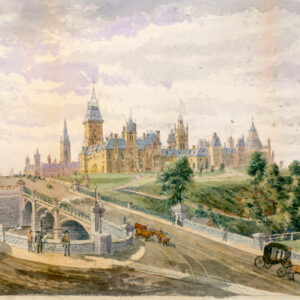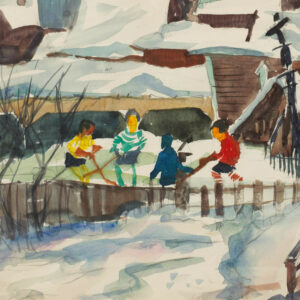-
Bayefsky, Aba (Canadian, 1923–2001)
Commissioned as an Official War Artist in the Royal Canadian Air Force in 1944, Bayefsky was a painter and teacher at the Ontario College of Art in Toronto. In 1945 he documented the Bergen-Belsen concentration camp after its liberation. He remained committed to confronting anti-Semitism in his art for the remainder of his career and created a number of works exploring his own Jewish heritage. Bayefsky was awarded the Order of Canada in 1979.
-
Beam, Carl (Ojibwe, M’Chigeeng First Nation, 1943–2005)
A mixed-media artist who experimented with the photographic medium and spearheaded the reclamation of space by contemporary Indigenous artists in Canada. Beam often worked in photographic collage that featured family photos, text, drawings, and recurring images such as bird anatomy, Christian iconography, and famed freedom fighters. His painting The North American Iceberg, 1985, was the first work recognized as contemporary art by an Indigenous artist purchased by the National Gallery of Canada. In 2005 he received the Governor General’s Award for Visual and Media Arts.
-
Beament, Harold (Canadian, 1898–1984)
A prominent figurative and landscape artist and a member of the Royal Canadian Academy of Arts, Beament was an official Canadian war artist during the Second World War. During his tenure as a war artist, he depicted scenes based on his experiences as a naval commander in the Mediterranean, the North Atlantic, the English Channel, and Newfoundland waters.
-
Belcourt, Christi (Métis, b.1966)
An artist, activist, and author known for her intricately patterned paintings that are inspired by floral motifs from traditional Métis beadwork. Belcourt’s paintings often feature bountiful and brightly coloured flowers, plants, and animals against a stark black ground. While celebrating the wonder and abundance of the natural world, Belcourt also directs our attention to the precarity of nature at this time of environmental crisis. She is the recipient of many prestigious honours including the Governor General’s Innovation Award (2016).
-
Bell, Vanessa (British, 1879–1961)
An interior designer and painter, Bell was a member of the Bloomsbury group, a British avant-garde circle of writers, artists, and intellectuals. An early adopter in Britain of non-representational painting, Bell reverted to a more naturalistic style after the First World War.
-
Belmore, Michael (Ojibway, Lac Seul First Nation, b. 1971)
A sculptor and installation artist primarily working with stone carving and copper metalsmithing techniques to create forms that reflect on Indigenous and settler relationships to nature. In response to the treatment of nature as a commodity, Belmore depicts the environment’s understated actions: watersheds, changing shorelines, the weathering of stone, and the landscape’s experience of time. He is the recipient of several awards and a member of the Royal Canadian Academy of Arts.
-
Borduas, Paul-Émile (Canadian, 1905–1960)
The leader of the avant-garde Automatistes and one of Canada’s most important modern artists. Borduas was also an influential advocate for reform in Quebec, calling for liberation from religious and narrow nationalist values in the 1948 manifesto Refus global. (See Paul-Émile Borduas: Life & Work by François-Marc Gagnon.)
-
Brownell, Franklin (Canadian, 1857–1946)
Born in Massachusetts but based in Ottawa for most of his career, Brownell was a widely recognized landscape painter, educator, and administrator. He trained in Boston and Paris before becoming the director of the Ottawa Art School in 1886. He taught many accomplished artists, including Pegi Nicol MacLeod, Ernest Fosbery, and Goodridge Roberts. Brownell’s own style ranged from social realism to Impressionism. His works are widely represented in the National Gallery of Canada.
-
Brymner, William (Scottish/Canadian, 1855–1925)
A painter and influential teacher who contributed greatly to the development of painting in Canada, Brymner instructed at the Art Association of Montreal. Several of his students, including A.Y. Jackson, Edwin Holgate, and Prudence Heward, became prominent figures in Canadian art. (See William Brymner: Life & Work by Jocelyn Anderson.)
-
 About the Author
About the Author
Jim Burant is an Adjunct Professor of Art History at Carleton University, as well as Director of the Ontario Region of the National Archival Appraisal Board of Canada.
-
 More Online Art Books
More Online Art Books
Read online or download the ACI’s incredible library of art books for free in French and English.
Learn More -
 Read from Beginning
Read from Beginning
From a rough and tumble lumber town, Ottawa has become a vibrant metropolitan centre with a centre of artistic excellence.
Learn More
